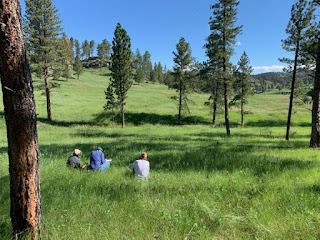A Different Side of Agriculture
Post by 2022 student Grace Covan
To begin with, I must admit that of the four sections of study for this project, the fire and forest management is the one I was most apprehensive about. I am an Animal Veterinary Sciences major with a background in beef and dairy production with my only fire experience being our class field trip to the eastern wildfire site. I was very surprised about the degree of correlation we discovered between the plant species found in our forest plots and the plant species we plant at home to feed to cattle. On my family farm, we growth and harvest our own hay. Our primary forage is Kentucky 31 fescue grass as it grows well in the southeastern heat. Rattail fescue was a species we found in almost every plot we sampled. While these are different varieties, I thought it was interesting to note how similar the plants looked in vastly different climates. Other similarities I noticed were thistle and vetch. Milk thistle, which grows in upstate South Carolina and in many of our Montana plots, is a Class A noxious weed that is toxic to cattle because of its ability to accumulate nitrogen. We must apply herbicides to our pastures at home to help with the eradication of milk thistle and we immediately pull it up if we find it in our fields. I was surprised to see how abundantly the plant was found in our plots. The cost of herbicides is extremely high, and I’m sure it would be near impossible to spray Montana rangeland. This brings into question the issue of sustainability. To me, sustainability means finding the balance between using the land to its fullest extent for production while also ensuring the land and resources continue to be productive for generations to come. This tends to be a fine line in beef production with herbicide and pesticide use falling into a bit of a grey area with cost vs benefit/harm.
Throughout this week, we have had several opportunities to spend some time with the ranch owners, Goz and Pat Segars. These interactions really drove home to me the devastation the fire had on the area and landowners. At one point, Goz became emotional when describing the fear of losing their house and cattle which made our work seem so much more valuable. It is very easy to get caught up in the work we’re doing and forget that our studies have real world application. Furthermore, the land is so green and lush as it is now that it is hard to imagine the thick wooded areas the Segars described as covering the entire ranch.
During our first meeting, Mr. Seagers mentioned that while the fire was devastating for a while, it provided a huge benefit to the cattle operation in that they had essentially gained new land without actually purchasing new land. He estimated that the ranch’s cattle carrying capacity had more than doubled. This concept really opened my eyes to the benefits of fire and prescribed burns that we’ve been discussing in class. During our meeting with the Department of Natural Resources and Conservation, the fire commissioner mentioned that there is a hesitancy among ranchers towards fire as it is generally considered a bad thing. At the start of this class, I had a pretty similar attitude as I knew almost nothing about prescribed burning. I do wonder if more landowners would be open to prescribed burning if they could see how much the land opened up and increased the cattle carrying capacity on this ranch.
Furthermore, it’s been very interesting for me to work hands-on with the Brown’s Transects and fuels data as these were completely new methods for me. I’ve really enjoyed being able to see different sides of agriculture that I would probably never see at home or in my classes.



